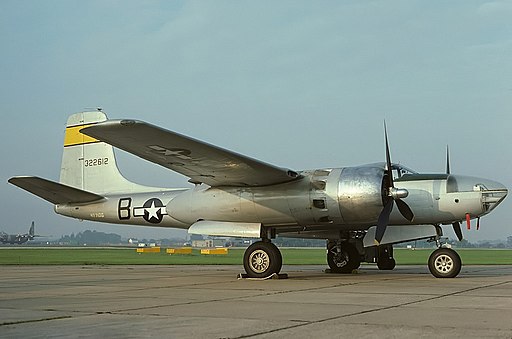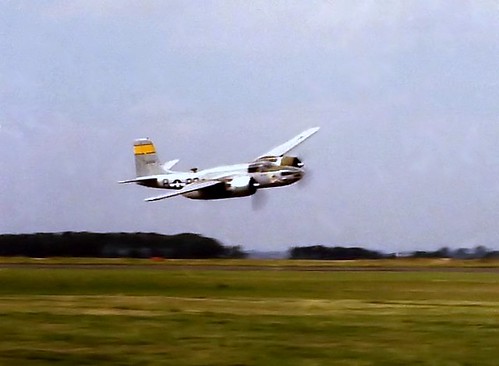
ASN Wikibase Occurrence # 28986
This information is added by users of ASN. Neither ASN nor the Flight Safety Foundation are responsible for the completeness or correctness of this information.
If you feel this information is incomplete or incorrect, you can submit corrected information.
| Date: | Sunday 21 September 1980 |
| Time: | 15:14 |
| Type: |  Douglas A-26C Invader |
| Owner/operator: | Cavalier Air Force |
| Registration: | N3710G |
| MSN: | 18759 |
| Fatalities: | Fatalities: 7 / Occupants: 7 |
| Aircraft damage: | Destroyed |
| Category: | Accident |
| Location: | near Biggin Hill, Kent -
 United Kingdom United Kingdom
|
| Phase: | Manoeuvring (airshow, firefighting, ag.ops.) |
| Nature: | Demo/Airshow/Display |
| Departure airport: | Biggin Hill Airport (BOH/EGKB) |
| Biggin Hill Airport (BOH/EGKB) | |
| Confidence Rating: |
Douglas A-26C Invader N6710G of the Cavalier Air Force crashed at Biggin Hill, Kent during a "Battle of Britain" Air display.
The aircraft was attempting to carry out a climbing roll in front of the crowd when the nose dropped sharply, and the aircraft continued rolling until it dropped vertically into a valley. The pilot and six passengers were killed. The Civil Aviation Authority subsequently introduced rules preventing passengers from being carried during air displays.
The aircraft was due to take part in a Battle of Britain Air Display and was programmed to take-off and go straight into a display lasting eight minutes. During the display briefing, which was held on the morning of the show, the pilot of the Invader asked if he could take-off early prior to the commencement of his display. No explanation was given for this request, nor did the pilot give any indication at the briefing as to what manoeuvres he intended to include in his display.
A suitable time in the programme for an earlier take-off could not be found and the pilot accepted the arrangements as originally scheduled.
According to a contemporary local newspaper report of the inquest in the pilot's death ("Sevenoaks Chronicle" - Saturday 31 January 1981):
"Tragic Silence THE CHILLING evidence given by witnesses at the inquest on Captain Donald Bullock and four of the six passengers who died with him in the wreckage of a World War II bomber at Biggin Hill air show last September lends a new significance to the apparently tiresome anxieties of people living near airfields. They are not, after all, merely fusspots intent on spoiling the enjoyment of others.
A few more yards and Bullock’s 37-year-old Invader bomber would have ploughed into houses with further appalling loss of life. Many people knew Bullock as an unstable personality, a daredevil flier with a penchant for dangerous stunts beyond the capacity of his museum-piece aeroplane and his own skill as a pilot; but not one of them bothered to tell the air show organisers. In a plane registered for survey work only and strictly limited as to aerobatics, Bullock sought permission to perform a barrel roll in front of 40,000 people. The show managers refused. Yet, clearly from the evidence at the inquest, a number of people had good reason to suspect, if only because of the pique he displayed, that he was likely to try it. No-one said a word, and Bullock was allowed to take off with six passengers in his old plane. He tried a barrel roll, failed, and killed them all.
One doctor told the coroner that he found Bullock “mentally disturbed” four years ago and felt he should not be allowed to fly at all. On the other hand only two months before the crash a Civil Aviation Authority doctor certified Bullock as fit to fly, even though he was known to be suffering from a depressive illness and was on tranquillisers.
Some six weeks after the Biggin Hill tragedy, the Historic Aircraft Association revealed that Bullock had declined to apply for one of its display pilot grading cards. He was apparently unwilling to comply with restrictions placed by the HAA on air show performances. An experienced display pilot who is a member of the HAA said of Bullock: “The way he flew was lunatic; but clearly he was a fact of life so we invited him to join and apply for one of our grading cards. The whole purpose of our voluntary code of conduct, which most display pilots accept, is to avoid the Civil Aviation Authority imposing something more horrendous in the wake of an accident.”
Now that is exactly what is likely to happen. The coroner at the Bullock inquest, Dr Mary McHugh, commented on the possibility of “a certain amount of recklessness” and is urging the CAA to control and monitor future air shows through a committee representing the organisers and experienced display pilots. This must mean the HAA, the only aviation organisation to date to demonstrate proper concern for public safety when old aircraft are being flown.
It is astounding and frightening that a man with Donald Bullock’s known record and reputation was allowed to fly over 40,000 people. It is clear that on the tarmac, in the pilots’ room, in the control tower he was known, as someone said, as “a “gung-ho flier” who would go to the limit. So many people knew, as the coroner said, that it seemed extraordinary that the Biggin Hill air show organisers did not know.
Small wonder people who live near airfields feel scared. Are there any more Bullocks flying about our skies whom their friends are too polite to talk about?"
N3710G was originally built for the USAAF in 1944 as 43-22612
Sources:
Sevenoaks Chronicle - Saturday 3 January 1981
Sevenoaks Chronicle - Saturday 31 January 1981
Stewart Tendler (22 September 1980). "Seven killed as bomber crashes at Biggin Hill". The Times. No. 60730. London. p. 1
https://reuters.screenocean.com/record/1045778 [accident video]
https://www.bournemouthecho.co.uk/news/10757303.amp/
https://www.alamy.com/stock-photo-a26-invader-crash-biggin-hill-108349435.html [fire fighters attending the wreckage]
https://www.key.aero/forum/historic-aviation/30810-invader-crash-at-biggin-hill
https://www.baaa-acro.com/sites/default/files/2019-11/N3710G.pdf [part of AIB report]
https://en.wikipedia.org/wiki/1980_Biggin_Hill_Invader_crash
http://www.warbirdregistry.org/a26registry/a26-4322612.html
http://napoleon130.tripod.com/id250.html
https://registry.faa.gov/aircraftinquiry/Search/NNumberResult
http://www.joebaugher.com/usaf_serials/1943_2.html
Media:
 Douglas A-26C Invader N3710G at RAF Mildenhall, Suffolk (EGUN) on 27.8.78
Douglas A-26C Invader N3710G at RAF Mildenhall, Suffolk (EGUN) on 27.8.78
 Douglas A-26C Invader N3710G at Leicester Air Display, 26.8.79.
Douglas A-26C Invader N3710G at Leicester Air Display, 26.8.79.Revision history:
| Date/time | Contributor | Updates |
|---|---|---|
| 27-Sep-2008 01:00 | ASN archive | Added |
| 12-Jan-2011 13:58 | harro | Updated [Phase, Nature, Source, Narrative] |
| 07-Jan-2012 06:07 | Uli Elch | Updated [Aircraft type, Cn, Departure airport, Destination airport, Source, Narrative] |
| 04-Jun-2013 20:11 | Dr. John Smith | Updated [Total fatalities, Total occupants, Location, Source, Embed code, Narrative] |
| 04-Jun-2013 22:58 | Dr. John Smith | Updated [Total fatalities, Total occupants, Embed code, Narrative] |
| 04-Jun-2013 23:05 | Dr. John Smith | Updated [Time, Location, Narrative] |
| 26-Dec-2016 17:00 | TB | Updated [Location, Narrative] |
| 22-Mar-2019 23:41 | RobertMB | Updated [Cn] |
| 22-Jul-2021 18:49 | Moley6699 | Updated [Category] |
Corrections or additions? ... Edit this accident description
The Aviation Safety Network is an exclusive service provided by:


 ©2024 Flight Safety Foundation
©2024 Flight Safety Foundation